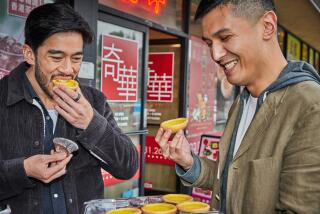Vacation Memories : Hanukkah Expressed Orientally in Hong Kong
A Happy Hanukkah banner, battered from the trip in my suitcase, hung across the draperies to create a Jewish atmosphere in a Hong Kong hotel room.
Our daughter, Perri, lit the Hanukkah candles in our miniature menorah. We caught a glimpse of her fingernails, all nicely trimmed except for the very long one on her pinkie. She explained the custom, common among Chinese men, of growing this pinkie nail to the length of the ring finger, thus insuring good luck and long life.
But the good luck was ours, to be reunited as a family.
Perri, age 24, had chosen to spend a year in Taiwan teaching English at the YMCA through the Volunteers in Asia program. The reunion in Hong Kong was a family Hanukkah present. What Perri did not know was that our plans included a very special Hanukkah gift. At the Hong Kong airport her 24-year-old brother, Hal, jumped from behind a pillar to surprise her.
Hal was the first of many surprises on the trip, and from that joyous moment both kids brought a fresh perspective to our experiences.
Those experiences began on our drive from the airport, when the frenetic pace of the city crept into the taxiâs interior. Torn between the desire to hang onto Perriâs every word or to sop up the sights around us, Hong Kong won out.
This water-bound city goes all out for the holiday season. An enormous Santa Claus balloon climbed up the side of a skyscraper. Glittering neon signs shouted âSeasons Greetingsâ to passers-by.
Shoes Off--Gladly
Perri, our Jewish ambassador to Taiwan, now indoctrinated with the Oriental culture, removed her shoes before entering our room in the Hong Kong hotel.
Soon we all removed our shoes in the room, footsore from pounding the pavements.
In contrast to the freedom with which we moved about Hong Kong, our one-day trip to Shenzhen, Peopleâs Republic of China, proved restrictive. We stood in interminable lines while our guide bought tickets and cleared documents for the two-hour train ride across the border from Hong Kong.
In the train station he assembled us in straight-back chairs around the perimeter of a formidable, marble-floored room where we vocally declared, one by one, how many cameras and watches each of us carried.
Popular Polaroids
In the Chinese commune we visited, one member of our group created a sensation with his Polaroid camera. Men and boys streamed into the street to pose for pictures, then huddled excitedly to ogle at their instant images.
We spent an hour in a Chinese kindergarten filled with meticulously crafted learning materials made by the teachers. Bright yellow-and-orange paper daisies and carrots stood upright in cardboard gardens as aids for counting activities. On the playground, cute but unsmiling children stiffly performed dances.
Although deadpan faces marked those children, in the marketplace we drew grins. We stared at women shoemakers and fruit sellers, who stared back in mutual curiosity. Not only did we four Americans have blue eyes, one of us--amazingly--spoke Chinese. Perri astounded them and us with her ability to communicate.
At lunch in a Shenzhen restaurant, just-right chemistry paved the way for an unusual incident. Tour guides distributed post cards for us to write while waiting for our meal. The tourist to my left said aloud, âWho shall I write this last post card to?â
âYou can write it to my mother,â I responded.
Greeting From China
So my mother in Michigan received a greeting from China when the following post card appeared in her mailbox:
âDear Mrs. Goldberg,
âIâm sitting next to your daughter at lunch in Shenzhen, China. She is having a wonderful time and wishes you were here.
âLove, A Complete Strangerâ
The contrast between freedom of movement in Hong Kong and Shenzhen became apparent again when we got off the bus to stroll through Shenzhenâs bustling market. Though cautioned to be back on the bus at a specific time, two of our more intrepid fellow travelers did not return when we were ready to leave. After much discussion and a great deal of anxiety, we left for our next stop, but we all knew we would not depart for Hong Kong until these passengers had rejoined the group.
âYou mean if they donât come back, we donât go?â Hal asked.
âYouâve got it, son. Youâd better brush up on your Chinese,â his father replied.
âItâs not the Chinese thatâs so difficult, itâs the chopsticks,â another passenger chimed in.
Dietary Rules Relaxed
Howard, Perri and Hal were adventurous with chopsticks and food. I was more squeamish and, although not kosher, attempted to avoid non-kosher pork products and shellfish. Warned by our guidebook that âThe Chinese cook anything with wings except airplanes, and anything with four legs except tables and chairs,â I stopped asking what I was eating.
In celebration of Hanukkah, however, we sought the familiar and ate at McDonaldâs, where we substituted French fries for the traditional potato latkes (pancakes). After all, dishes cooked in oil were customary. Weâd just have to do without the usual accompaniments, applesauce and sour cream.
In deference to Perri and Hal, I had bought a travel book on Hong Kong, written by and for young people and published by Lonely Planet Publications in Australia. It recommended the best place for seafood as Lei Yue Mun, a waterfront area on the Kowloon side of Hong Kong.
The cab driver looked at us suspiciously when we asked to be dropped at the dark, seamy dockside to catch a 5-cent ferry. Stepping off the sampan, we sloshed on wet floor boards, past tubs of sea creatures, and stumbled onto the very modest recommended restaurant.
We Pick, They Cook
Waiters came with cups, bowls and small plates. They then motioned (no one spoke English and Perri couldnât communicate in their dialect) for Howard and Hal to select dinner from the fish swimming lazily in the tanks.
Twenty minutes later three huge, cooked fish, enough to feed 12 people, appeared on our table with a variety of sauces. Five staring waiters and our kids cheered Howard on as he ate the head and eye, a Chinese tradition bringing good luck to the person devouring them.
Finally a fisherman in rubber boots stood obstinately by our table demanding to be paid for the fish. One special fish cost $47 and the total for the three was $80! And that wasnât the only surprise. Service, tip and sauces cost extra. Thatâs a lot of Hanukkah gelt (money), but weâll never tell a better rip-off fish story.
People travel to Hong Kong to sightsee and to eat, but shopping takes the cake for entertainment. As the kids put it, âWe shopped our brains out.â
Serious Shopping
For pure fun, buy chatchkes (trinkets) from the street sellers, but for serious shopping stay in the better stores where sales personnel are low-key.
High-pressure hucksters tried to hustle Hal into buying camera equipment in some stores, while a gentle old man in a recommended shop, Wah Mee Co. (21 E. Hankow Road), took an hour to explain the advantages of one lens over another.
I found stylish, well-priced, well-made sweaters at Chinese Arts & Crafts Ltd. The tittering and embarrassed looks on the shy salesgirlsâ faces when they inadvertently opened the dressing room and saw me in my bra will remain in my memory long after the sweaters have worn out.
Shopping fever was the only illness we picked up in Hong Kong. Even Howard and Hal caught it as we rode the escalators through the massive mall called Ocean Center, craning our necks to peer into optical, jewelry, clothing, electronics, linen and gift shops. âGotta shop, gotta shop,â our pumping adrenaline told us.
Each day before dinner, however, we returned to our hotel oasis to perform the Hanukkah ritual, the lighting of the candles. On a table by the window we placed our traveling menorah (candle holder), testifying in the Hong Kong night to the ancient miracle when a small cruse of oil in Jerusalemâs ancient temple lasted for eight days.
For many years to come, weâd also remember our eight days together in Hong Kong.
More to Read
Sign up for The Wild
Weâll help you find the best places to hike, bike and run, as well as the perfect silent spots for meditation and yoga.
You may occasionally receive promotional content from the Los Angeles Times.






